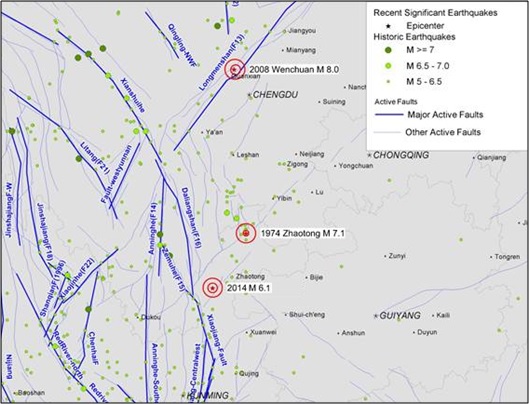Earthquake in Ludian, Yunnan Province, China
Status: Closed
| Type of posting | Posting date(EST): | Summary | Downloads |
|---|---|---|---|
| First Posting | 8/4/2014 1:00:00 PM |
|
First Posting | Summary
Posting Date: August 4, 2014, 1:00:00 PM
On Sunday, August 3, 2014, at 16:30 local time, an M6.1 earthquake struck south-central China’s Yunnan Province. According to several reports, the earthquake was the strongest to strike the area in 14 years. The epicenter was near the township of Longtoushan in Ludian County, just 11 km WSW of the county-level city of Ludian and 29 km WSW of Zhaotong, the district-level city of Ludian County. Its shallow depth of 10.0 km led to strong shaking and severe damage in many areas, particularly Zhaotong. Shaking was felt 300 km from the epicenter and reached the provinces of Guizhou and Sichuan. Hundreds of aftershocks have taken place in the region.
The hardest hit area is reported to be in Ludian County. According to Zhaotong City officials, over 200,000 households and over a million people have been affected by this earthquake. Over 390 casualties have been reported with at least 1,800 injured and these numbers may rise as rescue attempts continue throughout the area. Reports show severe damage in Ludian County, which is located northeast of the Yunnan Province capital city of Kunming, and has a population of about 430,000. Among the cities and towns in Ludian County, at least 12,000 homes have been destroyed and an additional 30,000 have been significantly damaged. At least one school has collapsed. Reports indicate flattened buildings and strewn bricks throughout the region.
Water is scarce due to ruptured water pipes while power and communication lines are down; however, as of Monday, August 4 (local time), power had been restored to about 19,000 homes. Rescue efforts have been hindered by heavy rain, destroyed roads, and landslides.
Seismicity in the Area
Sunday’s earthquake struck a very seismically active region, with the epicenter located about 8 km from the surface trace of the northeast-southwest oriented Zhaotong-Ludian fault. Since there has been no observed surface rupturing from this earthquake, the association with this fault is still not clear; however, seismic data indicates the earthquake is mainly on a strike-slip fault with a rupture plane orientation similar to the Ludian-Zhaotong fault. The closest major active fault to the epicenter is the Xiaojiang fault, located about 35 km away, where several M7 to M8 earthquakes have occurred.
The earthquake was located about 130 km southwest of the 1974 M6.5 Zhaotong earthquake, which killed more than 1,400 people and damaged over 66,000 buildings. The epicenter of Sunday’s event is also less than 400 km south of the 2008 M8.0 Wenchuan earthquake rupture. Although it occurred along a different fault system than the 2008 Wenchuan event, the active fault system in Yunnan has historically shown more seismic activity, particularly for moderately large earthquakes, than the Longmenshan fault that generated the 2008 Wenchuan earthquake.

Location of Sunday’s Earthquake and Major Faults in the Area (Source: AIR)
Exposure in China
The region affected by Sunday’s earthquake is largely an agricultural and mining region, and many of the collapsed homes are older; however, there are reports of new construction being destroyed or severely damaged.
In China’s more remote areas, the dominant construction types have historically been unreinforced masonry made from adobe or brick, or brick with a light wood frame. The buildings are generally massive, but they lack the lateral systems that can help withstand ground shaking from an earthquake. As a result, these buildings generally perform very poorly during seismic activity, even when the ground shaking intensity is low. Traditionally-designed buildings of reinforced concrete perform well during low ground shaking; however, they are still quite vulnerable at higher levels of ground motion.
New buildings in China are incorporating advanced earthquake-resistant features in their design and are also subjected to better construction practices and more stringent code enforcement. After the 1976 Tangshan earthquake, many unreinforced masonry homes were replaced with confined masonry, which is more stable due to the slender columns and beams (not load-bearing), which divide the large unreinforced masonry walls. New high-rise buildings are generally made of reinforced concrete and are built to strict code regulations, with the intent that they should perform better during strong earthquakes. About a tenth of high-rise commercial buildings are steel and all high-rise buildings are built to strict code enforcement.
AIR’s earthquake team is monitoring the situation as it continues to unfold and will provide updates as warranted.